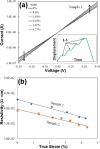Piezoresistive Response of Quasi-One-Dimensional ZnO Nanowires Using an in Situ Electromechanical Device
- PMID: 31457633
- PMCID: PMC6640942
- DOI: 10.1021/acsomega.7b00041
Piezoresistive Response of Quasi-One-Dimensional ZnO Nanowires Using an in Situ Electromechanical Device
Abstract
Quasi-one-dimensional structures from metal oxides have shown remarkable potentials with regard to their applicability in advanced technologies ranging from ultraresponsive nanoelectronic devices to advanced healthcare tools. Particularly due to the piezoresistive effects, zinc oxide (ZnO)-based nanowires showed outstanding performance in a large number of applications, including energy harvesting, flexible electronics, smart sensors, etc. In the present work, we demonstrate the versatile crystal engineering of ZnO nano- and microwires (up to centimeter length scales) by a simple flame transport process. To investigate the piezoresistive properties, particular ZnO nanowires were integrated on an electrical push-to-pull device, which enables the application of tensile strain and measurement of in situ electrical properties. The results from ZnO nanowires revealed a periodic variation in stress with respect to the applied periodic potential, which has been discussed in terms of defect relaxations.
Conflict of interest statement
The authors declare no competing financial interest.
Figures






References
-
- Thelander C.; Agarwal P.; Brongersma S.; Eymery J.; Feiner L. F.; Forchel A.; Scheffler M.; Riess W.; Ohlsson B. J.; Gösele U.; et al. Nanowire-based One-dimensional Electronics. Mater. Today 2006, 9, 28–35. 10.1016/S1369-7021(06)71651-0. - DOI
-
- Patolsky F.; Timko B. P.; Zheng G.; Lieber C. M. Nanowire-based Nanoelectronic Devices in the Life Sciences. MRS Bull. 2007, 32, 142–149. 10.1557/mrs2007.47. - DOI
-
- Yan R.; Gargas D.; Yang P. Nanowire Photonics. Nat. Photonics 2009, 3, 569–576. 10.1038/nphoton.2009.184. - DOI
LinkOut - more resources
Full Text Sources

